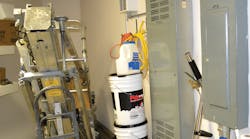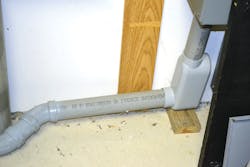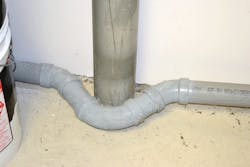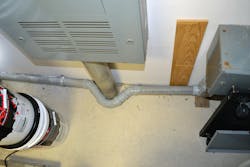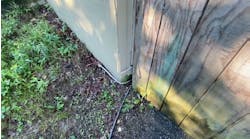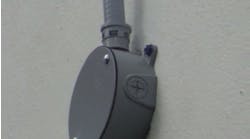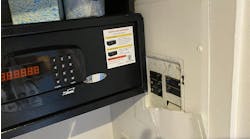All references are based on the 2017 edition of the NEC.
A Collection of Catastrophes
This collection of photos was sent to us by John A. Weber, principal electrical engineer for The Hartford Steam Boiler Inspection and Insurance Co. in Hartford, Conn. He spotted these NEC violations on a recent visit to a church building mechanical room that was originally built in 1973.
Photo 1 shows a classic example of what can happen in a room where panelboards, switchboards, and other electrical equipment are located. The working spaces for this equipment quite often get used for storage, even though Sec. 110.26(B) clearly states: “working spaces required by this section shall not be used for storage.” This Code rule can’t be any clearer than it is now.
The clear working space dimensions required by Sec. 110.26 extend from the front of the electrical equipment to a depth of 3 ft in front of the equipment. The width of the working space is required to be at least 30 in. wide or the width of the equipment if wider than that. The height of the working space extends from the floor to a height of at least 6½ ft or the height of the equipment if it is higher than that. This area must remain clear and free of obstacles that can increase the danger level for electrical workers when working on this energized electrical equipment.
The next group of photos show some creative conduit work.
Photo 2 shows where the installer connected this run of PVC conduit into the wireway beneath the panelboards. The cover for the LB conduit body is positioned where it will be very difficult to access the conductors and may create a violation of Sec. 314.29 if the wiring inside cannot be rendered accessible. Photo 3 provides a better angle to see the poor position of the LB cover. It also provides us our first look at the creative technique used to bend the conduit around an existing raceway.
In Weber’s words, “My guess is they tapped multiple single-phase or 3-phase branch circuit conductors for new loads somewhere in the building. Maybe new AC units? Maybe receptacle loads? I am just guessing here. The PVC goes into the auxiliary gutter, which is connected to the two lighting circuit panels as can be seen in Photo 1. Looks like the 208Y/120V, 3-phase, 4-wire system is the point of origin. The 45° and 90° fittings used are plumbing, drain, waste, and vent (DWV) pipes. They must have been white in color as you can see the offset fittings are spray painted gray.”
In Photo 4, the overspray from the spray paint can be seen on the floor and on the electrical conduits as well. This photo also shows the radius of the bends in the PVC conduit may not comply with Sec. 352.24 and Chapter 9, Table 2. I can’t be 100% sure of the trade size of this PVC conduit, but it appears to be somewhere between 1¼ in. to 2 in. Per Chapter 9, Table 2, the radius of the bend should be somewhere between 7¼ in. to 12 in., depending on the diameter of this conduit. It appears that this bend is much too tight to meet those requirements. These fittings may be fine for water, but conductors could be damaged if pulled through bends that are too tight.
Finally, Photo 5 shows us an overview of the installation. In Weber’s words: “It is possible a church volunteer (plumber) did this electrical work… not sure if it needs both a plumbing and electrical inspection... the plumbing inspector may cite the job for not using any primer on the DWV glue joints… it’s possible the electrons could leak out of those joints.”
